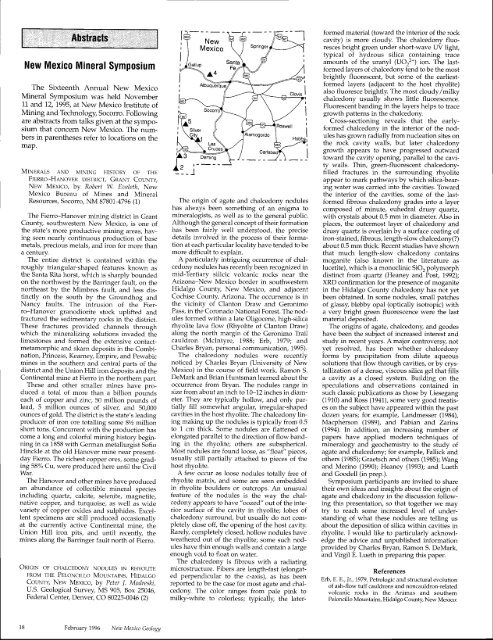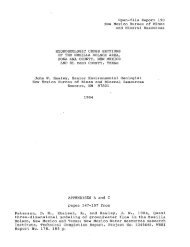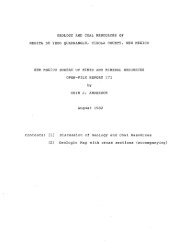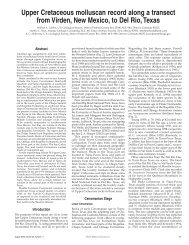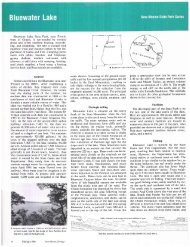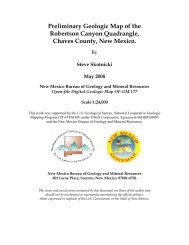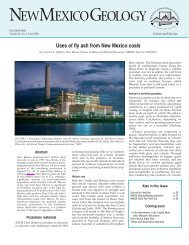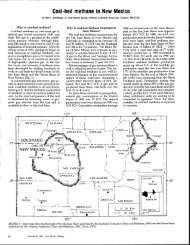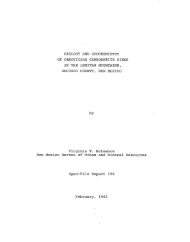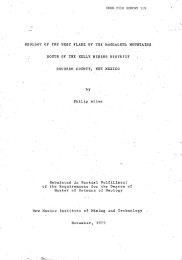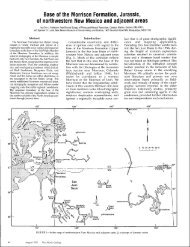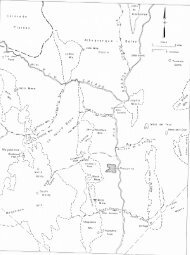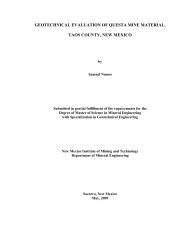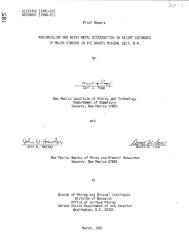New Mexico Mineral Symposium - New Mexico Bureau of Geology ...
New Mexico Mineral Symposium - New Mexico Bureau of Geology ...
New Mexico Mineral Symposium - New Mexico Bureau of Geology ...
Create successful ePaper yourself
Turn your PDF publications into a flip-book with our unique Google optimized e-Paper software.
<strong>New</strong> <strong>Mexico</strong> <strong>Mineral</strong> <strong>Symposium</strong><br />
The Sixteenth Annual <strong>New</strong> <strong>Mexico</strong><br />
<strong>Mineral</strong> <strong>Symposium</strong> was held November<br />
II and12,7995, at <strong>New</strong> <strong>Mexico</strong> Institute <strong>of</strong><br />
Mining and Technology, Socorro. Following<br />
are abstracts from talks given at the s)./mposium<br />
that concern <strong>New</strong> <strong>Mexico</strong>. The numbers<br />
in parentheses refer to locations on the<br />
map'<br />
MrNsnels AND MINING HISToRy oF THE<br />
Flsnno-He.lrovER DrsrRrcr, GneNr CouNrv,<br />
Nrw Mrxco, by Robert W. Eueleth, <strong>New</strong><br />
<strong>Mexico</strong> <strong>Bureau</strong> <strong>of</strong> Mines and <strong>Mineral</strong><br />
Resources, Socorro, NM 87801-4796 (1)<br />
The Fierro-Hanover minins district in Grant<br />
County, southwestern <strong>New</strong> Merico, is one <strong>of</strong><br />
the state's more productive mining areas, having<br />
seen nearly continuous production <strong>of</strong> base<br />
metals, precious metals, and iron for more than<br />
a century.<br />
The entire district is contained within the<br />
roughly trianguiar-shaped features known as<br />
the Santa Rita horst, which is sharplv bounded<br />
on the northwest by the Barringer'fiult, on ihe<br />
northeast by the Mimbres fault, and less distinctly<br />
on the south by the Groundhog and<br />
Nancy faults. The intruslon <strong>of</strong> the Fierro-Hanover<br />
granodiorite stock uplifted and<br />
fractured the sedimentary rocks in the district.<br />
These fractures provided channels through<br />
which the mineralizinq solutions invaded the<br />
limestones and formed the extensive contactmetamorphic<br />
and skarn deposits in the Combination,<br />
Princess, Kearney, Empire, and Pewabic<br />
mines in the southern and central parts <strong>of</strong> the<br />
district and the Union Hill irotr deposits and the<br />
Continental mine at Fierro in the northern r:art.<br />
These and other smaller mines have produced<br />
a total <strong>of</strong> more than a billion pounds<br />
each <strong>of</strong> copper and zinc, 50 mitiion pounds <strong>of</strong><br />
lead, 5 million ounces <strong>of</strong> silver, and 50,000<br />
ounces <strong>of</strong> gold. The district is the state's leading<br />
producer <strong>of</strong> iron ore totalling some 8rz million<br />
short tons. Concurrent with ihe production has<br />
come a long and colorful mining history beginning<br />
in ca 1858 with German metallurgist S<strong>of</strong>io<br />
Hinckle at the old Hanover mine neaipresentday<br />
Fierro. The richest copper ores, some grading<br />
58% Cu, were produced here until the Civil<br />
War.<br />
The Hanover and other mines have produced<br />
an abundance <strong>of</strong> col.lectible mineril species<br />
including quartz. calcite, selenite, magnetite,<br />
native copper, and turquoise, as well as wide<br />
variety <strong>of</strong> copper oxides and sulphides. Exceilent<br />
specimens are still produced occasionally<br />
at the currently active Continental mine, the<br />
Union Hill iron pits, and until recently, the<br />
mines along the Barringer fault north <strong>of</strong> Fierro.<br />
OzucrN op cHALCEDoNy NoDULES rN RHyoLITE<br />
FROM THE PELONCILLO MOUXTAWS, HTOETCO<br />
CouNrv, Nrw Mrxrco, by Peter l. Modreski,<br />
U.S. Geological Survey, MS 905, Box 25046,<br />
Federal Center, Denver, CO 80225-0046 (2)<br />
February 1996 <strong>New</strong> <strong>Mexico</strong> <strong>Geology</strong><br />
The origin <strong>of</strong> agate and chalcedony noduies<br />
has always been something <strong>of</strong> an enigma to<br />
mineralogists, as well as to the general public.<br />
Although the general concept <strong>of</strong> their formation<br />
has been fairly well understood, the precise<br />
details involved in the process <strong>of</strong> their formation<br />
at each particular locality have tended to be<br />
more difficult to explain.<br />
A particularly intriguing occurrence <strong>of</strong> chalcedony<br />
nodules has recently been recognized in<br />
mid-Tertiary silicic volcanic rocks near the<br />
Arizona-<strong>New</strong> <strong>Mexico</strong> border in southwestern<br />
Hidalgo County, <strong>New</strong> <strong>Mexico</strong>, and adjacent<br />
Cochise County, Arizona. The occurrence is in<br />
the vicinity <strong>of</strong> Clanton Draw and Geronimo<br />
Pass, in the Coronado National Forest. The nodules<br />
formed within a late Oligocene, high-silica<br />
rhyolite lava flow (Rhyolite <strong>of</strong> Clanton Draw)<br />
along the north margin <strong>of</strong> the Geronimo Trail<br />
cauldron (Mclntyre, 1988; Erb, 1979; and<br />
Charles Bryan, personal communication, 7995).<br />
The chalcedony nodules were recently<br />
noticed by Charles Bryan (University <strong>of</strong> <strong>New</strong><br />
<strong>Mexico</strong>) in the course <strong>of</strong> field work. Ramon S.<br />
DeMark and Brian lluntsman learned about the<br />
occurrence from Bryan. The noduies range in<br />
size from about an inch to l0-12 inches in diameter.<br />
They are typically hollow, and only partially<br />
fill somewhat angular, irregular-shaped<br />
cavities in the host rhyolite. The chalcedony lining<br />
making up the nodules is typically from 0.5<br />
to 1 cm thick. Some nodules are flattened or<br />
elongated parallel to the direction <strong>of</strong> flow banding<br />
in the rhyolite; others are subspherical.<br />
Most nodules are found loose, as "float" pieces,<br />
usually still partially attached to pieces <strong>of</strong> the<br />
host rhyoljte.<br />
A few occur as loose nodules totallv free <strong>of</strong><br />
rhyolite matrix, and some are r""r-r e-b"dd"d<br />
in rhyolite boulders or outcrops. An unusual<br />
feature <strong>of</strong> the nodules is the way the chalcedony<br />
appears to have "oozed" out <strong>of</strong> the interior<br />
surface <strong>of</strong> the cavity in rhyolite; lobes <strong>of</strong><br />
chalcedony surround, but usually do not completely<br />
close <strong>of</strong>f, the opening <strong>of</strong> the host cavity.<br />
Rarely, completely closed, hollow noduies have<br />
weathered out <strong>of</strong> the rhyolite; some such nodules<br />
have thin enough walls and contain a large<br />
enough void to float on water.<br />
The chalcedony is fibrous with a radiating<br />
microstructure. Fibers are length-fast (elongated<br />
perpendicular to the c-axis), as has been<br />
reported to be the case for most agate and chalcedony.<br />
The color ranges from pale pink to<br />
milky-white to colorless; typically, the later-<br />
formed material (toward the interior <strong>of</strong> the rock<br />
cavity) is more cloudy. The chalcedony fluoresces<br />
bright green under short-wave UV light,<br />
typical <strong>of</strong> hydrous silica containing trace<br />
amounts <strong>of</strong> the uranyl (UO2r*) ion. The lastformed<br />
layers <strong>of</strong> chalcedony tend to be the most<br />
brightly fluorescent, but some <strong>of</strong> the earliestformed<br />
layers (adjacent to the host rhyolite)<br />
also fluoresce brightly. The most cloudy/milky<br />
chalcedony usually shows little fluorescence.<br />
Fluorescent banding in the layers helps to trace<br />
growth patterns in the chalcedony.<br />
Cross-sectioning reveals that the earlyformed<br />
chalcedony in the interior <strong>of</strong> the nodules<br />
has grown radially from nucleation sites on<br />
the rock cavity walls, but later chalcedony<br />
growth appears to have progressed outward<br />
toward the cavity opening, parallel to the cavity<br />
walls. Thin, green-fluorescent chalcedonyfilled<br />
fractures in the surrounding rhyolite<br />
appear to mark pathways by which silica-bearing<br />
water was carried into the cavities. Toward<br />
the interior <strong>of</strong> the cavities, some <strong>of</strong> the lastformed<br />
fibrous chalcedony grades into a layer<br />
composed <strong>of</strong> minute, euhedral drusy qtartz,<br />
with crystals about 0.5 mm in diameter. Also in<br />
places, the outermost layer <strong>of</strong> chalcedony and<br />
drusy quartz is overlain by a surface coating <strong>of</strong><br />
iron-stained, fibrous, length-slow chalcedony(?)<br />
about 0.5 mm thick. Recent studies have shown<br />
that much length-siow chalcedony contains<br />
moganite (also known in the literature as<br />
lucetite). which is a monoclinic SiO, polymorph<br />
distinct from quartz (Heaney and Post, L992);<br />
XRD confirmation for the presence <strong>of</strong> moganite<br />
in the Hidalgo County chalcedony has not yet<br />
been obtained. In some nodules, small patches<br />
<strong>of</strong> glassy. blebby opal (optically isotropit) with<br />
a very bright green fluorescence were the last<br />
material deoosited.<br />
The origins <strong>of</strong> agate, chaicedony, and geodes<br />
have been the subiect <strong>of</strong> increased interest and<br />
study in recent years. A major controversy, not<br />
yet resolved, has been whether chalcedony<br />
forms by precipitation from dilute aqueous<br />
solutions that flow through cavities, or by crystallization<br />
<strong>of</strong> a dense, viscous silica gel that fills<br />
a cavity as a closed system. Building on the<br />
speculations and observations contained in<br />
such classic publications as those by Liesegang<br />
(1910) and Ross (1941), some very good treatises<br />
on the subject have appeared within the past<br />
dozen years; for example, Landmesser (1984),<br />
Macpherson (1989), and Pabian and Zarins<br />
(1994). In addition, an increasing number <strong>of</strong><br />
papers have applied modem techniques <strong>of</strong><br />
mineralogy and geochemistry to the study <strong>of</strong><br />
agate and chalcedony; for example, Fallick and<br />
others (1985); Graetsch and others (1985); Wang<br />
and Merino (1990); Heaney (1993); and Lueth<br />
and Goodell (in prep.).<br />
<strong>Symposium</strong> participants are invited to share<br />
their own ideas and insights about the origin <strong>of</strong><br />
agate and chalcedony in the discussion following<br />
this presentation, so that together we may<br />
try to reach some increased level <strong>of</strong> understanding<br />
<strong>of</strong> what these nodules are telling us<br />
about the deposition <strong>of</strong> silica within cavities in<br />
rhyolite. I would like to particularly acknowledge<br />
the advice and unpublished information<br />
provided by Charles Bryan, Ramon S. DeMark,<br />
and Virgil E. Lueth in preparing this paper.<br />
References<br />
Erb, E. E.,1r.,1979, Petrologic and structural evolution<br />
<strong>of</strong> ash-flow tuff cauldrons md noncauldron-related<br />
volcanic rocks in the Animas and southern<br />
Peloncillo Mountains, Hidalgo Comty, <strong>New</strong> <strong>Mexico</strong>:
Unpublished Ph.D. thesis, University <strong>of</strong> <strong>New</strong><br />
<strong>Mexico</strong>, Albuquerque NM,287 pp.<br />
Fallick, A. E., Jocelyn, J., Donnelly, T., Guy, M., md<br />
Behm, C., 1985, Origin <strong>of</strong> agates in volcmic<br />
from Scotland: Nature, v 313, pp. 672474.<br />
rocks<br />
Graetsch, H., Florke, O. W., and Miehe, G., 1985, The<br />
nature <strong>of</strong> water in chalcedonv and opal-C from<br />
Brazilian agate geodes: Physici and Chemistry <strong>of</strong><br />
<strong>Mineral</strong>s, v. 12, pp. 300-306.<br />
Heaney, P J., 7993, A proposed mechanism for the<br />
growth <strong>of</strong> chalcedony: Contributions<br />
and Petrology, v 71.5, pp. 66-74.<br />
to <strong>Mineral</strong>ogy<br />
Heaney, P J., and Post, J. E.,7992,Thewidespread distribution<br />
<strong>of</strong> a novel silica polymorph in microcrystalline<br />
quartz varieties: Science, v. 255, pp. ,14 l-443.<br />
Landmesser, M,1984, Das Problem der Achatgenese;<br />
Mitteilungen der Pollichia, v. 72, pp. 5-137. Bad<br />
Diirkheim, Poliichia-Museum.<br />
Liesegang, R. E., 1910, The origin <strong>of</strong> agate: Zentralblatt<br />
fiir <strong>Mineral</strong>ogle, 593 pp.<br />
Lueth, V W, and Goodell, P C., (in prep.), Fluid inclusion<br />
study <strong>of</strong> geodes from Rio Grande do Sul,<br />
Brazil: implications for the genesis <strong>of</strong> geodes:<br />
unpublished manuscript.<br />
Macpherson, H. G., 1989, Agates: London, British<br />
Museum (Natural History),72 pp.<br />
Mclntyre, D. H., 1988, Volcmic geology in parts <strong>of</strong> the<br />
southem Peloncillo Mountains, Arizona md <strong>New</strong><br />
<strong>Mexico</strong>: U.S. Geological Survey, Bulletin<br />
Pp.<br />
1671, L8<br />
Pabian, R. K., and Zarins, Andrejs, 1994, Banded<br />
agates, origins and inclusions: University <strong>of</strong><br />
Nebraska-Lincoln,<br />
pP.<br />
Educational Circular No. 12, 32<br />
Ross, C. S., 1941, Origin and geometric form <strong>of</strong> chalcedony-filled<br />
spherulites from Oregon: American<br />
<strong>Mineral</strong>ogist, v. 26, pp. 72I-737.<br />
Wmg, Yifeng, and Merino, Enrique, 1990, Self-organizational<br />
origin <strong>of</strong> agates: banding, fiber twisting,<br />
compositiory and dynamic crystallization model:<br />
Geochimica et Cosmochimica Acta, v 54, pp.<br />
1.627-1638.<br />
Carurturrn AND orHER ARSENATES FRoM GRANITE<br />
Gal, Hnelco CouNry NEW MEXrco*, by<br />
Ramon S- DeMark, 530 East Arch St.,<br />
Marquette, MI 49855; ar.d Paul F. Hlazta,<br />
Department 7822, MS-1405, Sandia National<br />
Laboratories, Albuquerque,<br />
(3)<br />
NM 87185-1405<br />
Granite Gap is in the central Peloncillo<br />
Mountains neir the "boot heel" <strong>of</strong> southwestern<br />
<strong>New</strong> <strong>Mexico</strong> and was one <strong>of</strong> the major producers<br />
<strong>of</strong> the San Simon mining district. It can<br />
be reached by traveting west oi l-10 for 16 mi<br />
past Lordsburg to Road Forks then south on<br />
U.S. 80 for approximately 11 mi. The mining<br />
area is on a hill southeast <strong>of</strong> the highway and is<br />
about one quarter <strong>of</strong> a mile from the highway.<br />
Most <strong>of</strong> the area is in private ownership as<br />
patented claims.<br />
Mining exploration at Granite Gap began<br />
about 1880, and there was a great deal <strong>of</strong> activity<br />
at the site in 1904 when it was visited by<br />
Lindgren, Graton, and Gordon (1910, p. 330).<br />
Extensive production stopped around 1915<br />
although small amounts <strong>of</strong> ore were shipped<br />
until at least 1926 and probably much later as<br />
reported by Gillerman (1958, p. 101). The mines<br />
were operated for lead and silver with some<br />
minor amounts <strong>of</strong> gold. The ore occurs in<br />
hydrothermal veins in Mississippian limestones<br />
near or adjacent to Tertiary dikes <strong>of</strong> a light-colored,<br />
fine-grained, quartz monzonite porphyry<br />
(Williams, 1978). No contact metamorphic<br />
effects were observed in the limestones adjaient<br />
to the dikes (Gillermary 1958; Williams, 1978)<br />
although an extensive contact metamorphic<br />
aureole does occur around the later, genetically<br />
related, main quartz monzonite intrusive<br />
(Williams, 1978). -<br />
The main workings consist <strong>of</strong> several shafts<br />
and a number <strong>of</strong> adits, all <strong>of</strong> which were apparently<br />
interconnected at one time. Workings that<br />
are currently accessible form a Byzantine series<br />
<strong>of</strong> drifts, declines, stopes, and "dog holes,"<br />
Mining by "following the ore" is probably<br />
responsible for this extreme irregularity <strong>of</strong><br />
openings and suggests that the ore shoots<br />
themselves were highly irregular although they<br />
were always near the intrusive dikes.<br />
Arsenic was detected early and was attributed<br />
to oxidi./ed tetrahedrite-group minerals<br />
[(Cu, Fe)rr(Sb,As)rS1aJ (Lindgren et aI., 1910)<br />
although no relict tetrahedrite has been found.<br />
Williams (1978) reported a number <strong>of</strong> arsenate<br />
minerals but did not provide specifics <strong>of</strong> occurrence,<br />
associations, and physical descriptions<br />
for most <strong>of</strong> them. He did, however. note the<br />
ubiquitous presence <strong>of</strong> arsenopyrite in unctuous<br />
phlogopite surrounding the other sulfides.<br />
This material was not detected during this<br />
investigation. Williams (1978) determined that<br />
the silver in the ore was originally derived ftom<br />
matildite [AgBiS2l embedded in the galena.<br />
Granite Cao is relativelv unknown to mineral<br />
collectors witil the exceDtion <strong>of</strong> a small cadre <strong>of</strong><br />
micromineral enthusiasts. This is probably due<br />
to the remoteness <strong>of</strong> the area plus the paucity <strong>of</strong><br />
hand-sized specimens. However, it is now<br />
revealed to have a siqnificant suite <strong>of</strong> attractive<br />
secondary arsenate minerals plus a number <strong>of</strong><br />
additional snecies o{ interest to mineral collectors.<br />
Arsenate species found during this study,<br />
in order <strong>of</strong> abundance, are mimetite [Pbs<br />
(AsOfrCll, conichalcite [CaCu(AsOf(OH)J,<br />
beudantite [PbFe"3*(AsO)(SO)(OH)61, agardite-(Y)<br />
[(!Ca)Cuu(AsO/3(oH)63H2o] (Wil-<br />
Iiams, 1978, identified the related species mixite),<br />
adamite (cuprian) [(Zn Cu)r(AsO/(OH)J,<br />
olivenite [Cur(AsOr)(OH)], and carminite<br />
[(PbFe23* (AsO;XoFI)r]. Species identification<br />
was accomplished by physical characteristics<br />
and electron microprobe analysis.<br />
Mimetite color and habit are quite variable.<br />
Crystals may be bright canary yellow or completely<br />
white, and the habit varies from 1 mm<br />
spheres to hexagonal prisms that may terminate<br />
with the r:inacoid or b(anch into "wheat<br />
sheaves." Conichalcite is typically grass green<br />
and may be individual spheres or mats and<br />
crusts <strong>of</strong> intergrown sheaves. Coverage <strong>of</strong> some<br />
specimens exceeds several square centimeters.<br />
Beudantite is found in verv smali (less than 0.1<br />
mm) crystals that are yellow green to brown<br />
and subtranslucent. Agardite-(Y) occurs in<br />
greenish-blue, acicular sptays with individual<br />
crystals to 0.5 rnm. Some crystals are extremely<br />
fine whereas others are sufficiently coarse to<br />
recognize the hexagonal symmetry. It is found<br />
with conichalcite and adamite but is difficult to<br />
distinguish from the ubiquitous aurichalcite<br />
[(Zn,Cu)u (CO3)2(OH)6]. Adamite was determined<br />
to be cuprian by electron microprobe<br />
analysis. Individual, bluish-green, equant crystals<br />
about 0.2 mm across are translucent with<br />
white patches. Olivenite was determined to be<br />
zlnciai, and the crystals are 0.2 to 0.3 mm and<br />
equant. They are lustrous, transparent, and seablue<br />
green. Carminite occurs as bright,<br />
carmine-red soravs less than 0.2 mm across and<br />
as drusy cruits'with very finely crystalline<br />
"blebs" <strong>of</strong> yellow-green beudantite. A copper<br />
arsenate, as yet to be identified, was found as<br />
0.1 mm purple-red octahedra and remains<br />
under study.<br />
Bromargyrite [AgBr] is usually found as indi-<br />
vidual,0.5 mm, olive-green crystals perched on<br />
crusts <strong>of</strong> conichalcite. Aurichalcite and rosasite<br />
[(Cu,Zn)r(CO)(OH)r] are both found in attractive<br />
specimens in a number <strong>of</strong> areas throughout<br />
the mines, always in association with coiorless,<br />
bladed, hemimorphite [ZnoSirOr(OH)rHrOl<br />
crystals. Carminite was found in a single specimen<br />
on the dump <strong>of</strong> an adit high on the northwest<br />
side <strong>of</strong> the Granite Gap hill. This adit and<br />
dump were the source <strong>of</strong> the greatest volume<br />
and variety <strong>of</strong> arsenates. Pyrite [FeS2l oxidized<br />
to goethite [FeO(OH)] is common on this<br />
dump, and blue botryoidal hemimorphite can<br />
be found as well. Plattnerite [PbOr] associated<br />
with white mimetite and brown beudantite is<br />
found in this adit in a small area with difficult<br />
access. Willemite in colorless, hexagonal prisms<br />
and botryoidal, gray smithsonite [Zn(CO3)l<br />
along with two single crystals <strong>of</strong> azurite<br />
lCu.(CO.)r(OH)21 were found on the dump <strong>of</strong><br />
the hish;,st adit-on ihe southwest side <strong>of</strong> the<br />
hill.<br />
As the only known <strong>New</strong> <strong>Mexico</strong> location for<br />
carminite and one <strong>of</strong> a very few arsenate locations<br />
in <strong>New</strong> <strong>Mexico</strong>, Granite Gap has added<br />
one more interesting chapter to the story <strong>of</strong><br />
<strong>New</strong> <strong>Mexico</strong> minerals although the story is by<br />
no means complete.<br />
References<br />
Gillerman, Elliot, 1958, <strong>Geology</strong> <strong>of</strong> the central<br />
Peloncillo Mountains, Hidalgo County, <strong>New</strong><br />
<strong>Mexico</strong>, and Cochise County, Arizona: <strong>New</strong> <strong>Mexico</strong><br />
<strong>Bureau</strong> <strong>of</strong> Mines and <strong>Mineral</strong> Resources, Bulletin<br />
5/, rJlD.<br />
Lindgren. Waldemar, Graton, Louis C., md Gordor!<br />
Charles, II, 1910, The ore deposits <strong>of</strong> <strong>New</strong> <strong>Mexico</strong>:<br />
U.S. Geological Suwey, Pr<strong>of</strong>essional Paper 68.<br />
Williams, S. A.,7978, <strong>Mineral</strong>ization at Granite Gap,<br />
Hidalgo County, <strong>New</strong> <strong>Mexico</strong>: <strong>New</strong> <strong>Mexico</strong><br />
Geological Society, Guidebook 29, pp. 329130.<br />
* Part <strong>of</strong> this work was performed at Sandia<br />
National Laboratories, operated for the U.S.<br />
Department <strong>of</strong> Energy under contract number<br />
DE-AC04-94AL85000.<br />
MnlEnelocv oF THE TODILTo URANIL\4 DEPoSITS,<br />
Gneurs DrsrRrcr, Nrw Muxrco, by William R.<br />
Bergl<strong>of</strong>, University <strong>of</strong> Maryland, Asian<br />
Division, Unit 5060 Box 0100, AOP AP 96328-<br />
0100; and Virginin T. McLemore, <strong>New</strong> <strong>Mexico</strong><br />
<strong>Bureau</strong> <strong>of</strong> Mines and <strong>Mineral</strong> Resources,<br />
Socorro, NM 87801-4796 (4)<br />
Uranium minerals in the Grants district were<br />
first discovered in the late 1940s in the Todilto<br />
Limestone, which has yielded about 2oh oI the<br />
total uranium production from the district. The<br />
first uranium minerals discovered and mined<br />
were brightly colored yellow minerals.<br />
Significant quantities <strong>of</strong> "black ore" containing<br />
uraninite (pitchblende) and c<strong>of</strong>finite were discovered<br />
as mining progressed, sometimes associated<br />
with blue-black vanadium oxide minerals,<br />
and it became evident that the yellow minerals<br />
formed by secondary near-surface oxidation<br />
<strong>of</strong> the black ores. Yellow minerals are rare<br />
or absent in the deeper mines. Lead-uranium<br />
isotopic dating <strong>of</strong> uianinite indicates that it<br />
formed shortly after the limestone was deposited;<br />
the yellow minerals formed at various later<br />
flmes.<br />
Fluorite, barite, and pyrite are the most common<br />
accessory minerais in and near the uranium<br />
ore. Fluorite occurs in small crystals and<br />
fine-grained irreguiar replacements; known<br />
<strong>New</strong> <strong>Mexico</strong> <strong>Geology</strong> February 1996 79
occurrences are roughly coextensive with uranium<br />
minerals and are probably not related to<br />
fluorite vein deposits in the nearby Zuni district.<br />
Uraninite occurs in disseminations and<br />
replacements along bedding or irregularly<br />
throughout mineralized limestone, and occasionally<br />
along fractures. Where uraninite is<br />
abundant, the limestone may appear red from<br />
associated fine-grained hematite. Microscopic<br />
galena crystals are associated with high-grade<br />
uraninite; much <strong>of</strong> the lead in the galena may<br />
have been derived from decay <strong>of</strong> uranium. A<br />
few deposits extend into the Entrada<br />
Sandstone, immediately below the Todilto, with<br />
uraninite filling pore spaces between sand<br />
grains. The blue-black vanadium minerals are<br />
mainly hiiggite and paramontroseite and <strong>of</strong>ten<br />
occur in fractures associated with coarse calcite.<br />
The most common yellow mineral in oxidized<br />
uranium-vanadium ore is tyuyamunite, the ca1cium<br />
analog <strong>of</strong> carnotite, which forms in the<br />
high-calcium limestone environment. It is<br />
abundant in thin but conspicuous coatings on<br />
fractures and bedding surfaces in the limestone,<br />
and occasionally as platy crystals or in pulverulent<br />
masses. Tyuyamunite occurs along with the<br />
related lower hydrate metatyuyamunite; the<br />
minerals differ in their water content and form<br />
reversibly from each other depending on<br />
humidity conditions. The yellow uranium silicate<br />
uranophane may form where the ore is low<br />
in vanadium. It occurs as radiating clusters <strong>of</strong><br />
acicular crystals on fracture or bedd-ing surfaces<br />
and occasionally as thicker felted masses or<br />
showy acicular crystals in open spaces.<br />
Schroeckingerite is rare in oxidized ore, occurring<br />
as light-green platy crystals that fluoresce<br />
brilliant yellow green in short-wave ultraviolet<br />
radiation.<br />
Other scarce minerals in oxidized or oartiallv<br />
oxidized deposits are the lead-uranium oxide<br />
curite, the calcium vanadates hewettite and<br />
metahewettite, and two new minerals from the<br />
Grants district: santafeite. a complex manganese<br />
vanadaie, and grantsite, a sodium calcium<br />
vanadate. Goldmanite, another new mineral,<br />
is a vanadium-rich garnet related to andradite<br />
and grossularite; ii occurs in the Lagr.rna<br />
area where a Todilto deposit extending into the<br />
Entrada sandstone was intruded by a basaltic<br />
igneous sill, forming various calc-silicate metamorphic<br />
minerals including andradite-grossularite.<br />
Small crystals <strong>of</strong> goldmanite formed in<br />
vanadium-rich parts <strong>of</strong> the metamorphosed<br />
deposit.<br />
Several additional minerals occur in or<br />
around the Todilto deposits; their relationship to<br />
uranium-vanadium mineralization is not cl-ear.<br />
These include small quartz crystals, manganese<br />
oxides, and iron oxides resembling limonite.<br />
Coarsely crystalline black calcite and paragenetically<br />
later white calcite are common in fractures<br />
and open spaces. Rare pyrite-coated scalenohedral<br />
calcite crystals are also observed. A few<br />
other minerals may occur as very minor constituents<br />
<strong>of</strong> the host rocks and possiblv <strong>of</strong> the<br />
deposits; some have been reported or tentatively<br />
identified in previous work but were not confirmed<br />
in this study. The most significant or<br />
interesting minerals from the Todilto deposits<br />
are: uraninite, UOr; c<strong>of</strong>finite, U(SiOl)l ,(OHy*^;<br />
haggite,<br />
!2O2(OH)3;<br />
paramontroseite.VOr; fluorite,<br />
CaF2; barite, BaSOn; pyrite, FeSr; c-lcite,<br />
CaCOr; hematite, FerOr; galena, PbS; tyuyamunite,<br />
Ca(UO2)2 (Y O 4)z 5-8y2H2O; metatyuyamunite,<br />
Ca(UO2)2 (Vot2 3-5HrO; uranophane,<br />
Ca(UOr)r(SiO, OH)z.5HzO; schroeckingerite,<br />
NaCarU:q(Co;), SooF totiro; curire, pbfUro,,<br />
20 February 1996 <strong>New</strong> <strong>Mexico</strong> <strong>Geology</strong><br />
'4HrO; hewettite, CaVoOro.9HrO; metahewettite,<br />
Ca V.OI<br />
o.3H2O; santa f?i te", ( N.An, Fe,A l,Mg)8Mn8_<br />
(Ca,Sr,Na),,, (VOr16(OH,O)ro 8HrO; grantsite,<br />
NarCaV, O32 .8H2O; goldmanite, Car(V,Fe,Al)2<br />
si3o12.<br />
TELLURIDE oCCURRENCES IN THE FOUR-CoRNER<br />
SrArES, U.S.A., by Bruce Geller, Advanced<br />
Geologic Services, 700 Vista Lane,<br />
Lakewood, CO 80215<br />
Tellurium (abbreviated Te) is one <strong>of</strong> the rarest<br />
elements for.rnd in the earth's crust, with an<br />
average abundance far lower than platinum's.<br />
Though rare, telluride minerals (those bearing<br />
teliurium) are noted in all 13 mining states in<br />
the western U.S., including the four-corner<br />
states <strong>of</strong> Arizona, Colorado, <strong>New</strong> <strong>Mexico</strong>, and<br />
Utah. For the remainder <strong>of</strong> this discussion, the<br />
term telluride minerals will be restricted to<br />
unoxidized species, excluding tellurites and tellUIates.<br />
Curiousiy, certain areas are broadly enriched<br />
in telluride minerals such as Colorado, whereas<br />
adjacent areas like Wyoming contain few Tebearing<br />
deposits. In fact, Colorado has roughly<br />
40 times as many telluride occurrences per<br />
square kilometer as Wyoming, and more than<br />
five times as many per square kilometer as an<br />
average western mining state. <strong>New</strong> <strong>Mexico</strong> and<br />
Utah are examples <strong>of</strong> typical westem mining<br />
states in terms <strong>of</strong> Te occurrences Der souare<br />
kilometer, whereas Arizona contains roughly<br />
one third the number <strong>of</strong> Te occurrences <strong>of</strong> average<br />
western mining states.<br />
Arizona contains telluride minerals with the<br />
broadest chemical diversity in the four-corner<br />
states. Most <strong>of</strong> this diversity is found in the<br />
Bisbee district, which contains more than half <strong>of</strong><br />
Arizona's tellurides. In fact. Bisbee's 18 reported<br />
telluride species represent the largest number<br />
<strong>of</strong> telluride species in any depost that the<br />
author is aware <strong>of</strong> in the world. In Colorado,<br />
the Jamesown district contains at least L6 unoxidized<br />
telluride minerals, which represent 65%<br />
<strong>of</strong> Colorado's telluride mineral varieties.<br />
Surprisingly, Utah has the least diverse tel-<br />
Iuride minerals <strong>of</strong> the four-corner states (perhaps<br />
because <strong>of</strong> inadeouate identificatjon techniques),<br />
even though ii has the typical number<br />
<strong>of</strong> occurrences per square kilometer. Another<br />
unexpected result <strong>of</strong> this investigation is that<br />
certain statistical and geologic evidence suggests<br />
that Arizona should contain more Te-bearing<br />
mining districts than are presently known.<br />
The mineralogy <strong>of</strong> the telluride minerals in<br />
the four-corner states is fairly typical <strong>of</strong> Te-bearing<br />
districts worldwide. The most reported telluride<br />
mjnerals in the region are (in decreasing<br />
order <strong>of</strong> reported district-wide occurrences,<br />
with the number <strong>of</strong> reports in parentheses): petzlte<br />
(25), hessite (22), altaite (18), tetrad).'rnite<br />
(18), sylvanite (16), calaverite (14), and native<br />
tellurium (14). Detailed literature examination<br />
indicates that altaite, native tellurium, hessite,<br />
and tetradymite are perhaps the most comrnonly<br />
reported telluride minerals worldwide, occurring<br />
in a broad range <strong>of</strong> geologic environments.<br />
The presence <strong>of</strong> petzile, sylvanite, and calaverite<br />
in the above list suggests the relative prevalence<br />
<strong>of</strong> Au-tellurides in the four-comer states.<br />
One might infer from above that the general<br />
trend is for areas with the most reported Tebearing<br />
minerals to contain the widest diversity<br />
in their telluride mineral chemistry. This is<br />
basically true. For example, Co.lorad'o has at<br />
least 43 Te-bearing districts, 24 reported telluride<br />
minerals, and tellurides with more varied<br />
chemical elements than other areas in this<br />
study. On the other hand, Utah has the least<br />
number <strong>of</strong> verified telluride minerals, hence the<br />
least diversity in telluride mineral chemistry.<br />
The tellurides present in the four-corner<br />
states are representative <strong>of</strong> many worldwide<br />
hvdrothermal svstems with low to moderate<br />
temperatures <strong>of</strong> formation. Tellurides were<br />
deposited late in the paragenetic sequence <strong>of</strong><br />
mineralization and are associated with certain<br />
Mesozoic/Cenozoic metal-bearing intrusions,<br />
in many cases Cu and/ot Mo alkalic porphyry<br />
systems. Tellurides are found either in the porphyries,<br />
limestone replacements, skarns, or<br />
most commonlv in epithermal veins. An entirely<br />
different origin is illustrated by the Vulcan<br />
deposit near Cunnison, Colorado, which is a<br />
submarine exhalative massive-sulfide deposit<br />
<strong>of</strong> Proterozoic age.<br />
Most <strong>of</strong> the telluride occurrences in the western<br />
U.S. do not occur in distinct belts. Telluride<br />
occurrences in Arizona are confined to the far<br />
southeast corner <strong>of</strong> the state except for the Tiger<br />
district near the state's center. Colorado's telluride<br />
occurrences generally fall within a triangle,<br />
with one leg the northeast-southwesttrending<br />
Colorado mineral beit, another leg<br />
trending east from La Plata to an area southeast<br />
<strong>of</strong> Westcliffe (west <strong>of</strong> Pueblo), and a third leg<br />
trending roughly north from Westcliffe to<br />
jamestown, northwest <strong>of</strong> Boulder. A1l <strong>of</strong> <strong>New</strong><br />
<strong>Mexico</strong>'s telluride occurrences lie in the southwest<br />
part <strong>of</strong> the state except for two districts<br />
northeast <strong>of</strong> Taos. Utah's telluride occurrences<br />
are confined to the western half <strong>of</strong> that state.<br />
Four hypotheses were tested to explain these<br />
large-scale distribution patterns. The first concerns<br />
the distribution <strong>of</strong> alkalic rock complexes,<br />
with which telluride deposits are known to<br />
commonly affiliate (Mutsihler et a1., 1985). The<br />
four-corner states have anomalously high proportions<br />
<strong>of</strong> alkalic intrusions per square kilometer<br />
<strong>of</strong> ground surface, yet they do not uniformly<br />
contain above-average numbers <strong>of</strong> telluride<br />
occurrences within their boundaries. The<br />
second concerns the timing <strong>of</strong> peak alkalic<br />
igneous activity. In Colorado this occurred<br />
26-76Ma ago, which is identical to peak alkalic<br />
activity in <strong>New</strong> <strong>Mexico</strong> and three other westem<br />
states (Mutschler et aI., 1992), yet Colorado's<br />
tellurides per square kilometer far surpass the<br />
other four states'. The third hvpothesis concerns<br />
plate tectonic relations, wtriitr do not provide<br />
a clear answer. Finally, metal inheritance<br />
tied to underlying basement lithology/age was<br />
examined and was the most successful <strong>of</strong> the<br />
four hlpotheses. Although it cannot yet be<br />
proved, the composition <strong>of</strong> Colorado's basement<br />
appears to be the most reasonable explanation<br />
for its anomalously high density <strong>of</strong> telluride<br />
occurrences per square kilometer.<br />
References<br />
Mutschler, F. E., et al., 1985, Precious metal deposits<br />
related to alkaline rocks in the North Amirican<br />
Cordillera-an interpretive review: Tians. Geol.<br />
Soc. S. Afr. 88:355J7.<br />
Mutschler, F. E., et al., 1992, Alkaline and related<br />
igneous rocks and associated mineral deposits-an<br />
album <strong>of</strong> space-time snapshots <strong>of</strong> the Westem U.S.<br />
and Canada: U.S. Geological Survey, MF Map<br />
Series, 174 p.<br />
Gpor-ocv AND MINERALocy oF TELLURruM MINER-<br />
ALIZATIoN IN THE LoNE PtNr rrarun ente.
Wrrcox DlsrRrcr, CATRoN CouNry NEw<br />
MEXIco, by Virgil W. Lueth, <strong>New</strong> <strong>Mexico</strong><br />
<strong>Bureau</strong> <strong>of</strong> Mines and <strong>Mineral</strong> Resources,<br />
Primary mineralization occurs as fracture fillings<br />
in veinlets in the silicified flow-banded<br />
rhyolite at most prospects. Disseminated min-<br />
Socorro, NM 87801-4796; loan T. Beyer,5030<br />
Beyer Road, Las Cruces, NM 88011; and<br />
Ronald B. Gibbs,Phelps Dodge Corp., Tyrone,<br />
NM 88065 (5)<br />
eralization is also oresent. At the Lone Pine<br />
mine, primary mineralization occurs in larger<br />
pods in a large zone <strong>of</strong> silicified flow-banded<br />
rhyolite and silicified andesite. Primary miner-<br />
The Lone Pine mine area, in the Wilcox district,<br />
Catron County, <strong>New</strong> <strong>Mexico</strong>, has been the<br />
site <strong>of</strong> modest mineral production. The district<br />
has produced 5 tons <strong>of</strong> tellurium and less than<br />
100 ounces <strong>of</strong> gold and silver (1.23 oz. Au and<br />
19.0 oz Ag <strong>of</strong>ficially reported). The Wilcox district<br />
is also credited with the production <strong>of</strong><br />
L0,603 tons <strong>of</strong> fluorite (McAnulty, 1978). Despite<br />
the production <strong>of</strong> metal and fluorite, the area is<br />
probably best known for its telluriurn minerals.<br />
However, very little systematicwork onthe mineralogy<br />
has been attempted prior to this study.<br />
The ore deposits are hosted by Tertiary volcanic<br />
and volcaniclastic rocks, mainly in the<br />
Mogollon and <strong>Mineral</strong> Creek andesite units <strong>of</strong><br />
Ratt6 et aI. (7979\. <strong>Mineral</strong>ization tends to be<br />
confined to north- and northwest-trending fault<br />
zones that were in turn intruded by flowbanded<br />
rhyolite dikes. The rhyolites are bleached,<br />
silicified, and iron stained, to various degrees.<br />
The adjacent volcanic rocks are argillized, locally<br />
silicified, and strongly iron stained in places.<br />
Previous workers in the district attribute mineralization<br />
to late-stage volcanism and buried<br />
plutonism related to the development <strong>of</strong> the<br />
ring cornplex <strong>of</strong> the Bursum caldera<br />
(Oligocene).<br />
alization consists <strong>of</strong> pyrite, fluorite, tellurium,<br />
and molybdenum. A precious-metal telluride,<br />
krennerite(?), was identified for the first time in<br />
the district during this study. A vertical mineralogical<br />
zonation is apparent with pyrite stratigraphically<br />
lowest grading into pyrite-tellurium<br />
assemblage followed by a fluorite-rich zone<br />
at the highest elevations. Tellurium mineralization<br />
is strongest at the pyrite-fluorite transition<br />
zone. Ballmer (1932) reported bismuthinite in<br />
the ores, but the mineral was not observed in<br />
this study.<br />
As a result <strong>of</strong> the unique chemistry <strong>of</strong> tellurium-oxygen<br />
molecules and their behavior in the<br />
weathering environment, tellurites and tellurates<br />
are the most abundant tellurium species in<br />
the district. Tellurite and paratellurite (both<br />
TeO") were observed in the district for the first<br />
time-, usually growing on native tellurium. In<br />
additiory the weathering <strong>of</strong> pyrite and native tellurium<br />
gives rise to a host <strong>of</strong> iron tellurate minerals<br />
including emmonsite (FerTeuO,2HrO),<br />
mackayite (FeTe2O5(OH)), sonoraite (FeTeO,<br />
(OH).H2O), blakeite (Fer(Teo3)3) poughite (Fe2<br />
(TeO.)r(SO/.3HrO), and perhaps other, more<br />
rare, iron tellurates (rodalquilarite and cuzticite).<br />
The district is the type locality for a copper tellurate,<br />
rajite (CuTerO5). A second copper tellurate,<br />
teineite (CuTeO..2H2O), was also noted during<br />
this study (rajite was reported as a pseudomolph<br />
<strong>of</strong> teineite by Williams, 7972). The presence <strong>of</strong><br />
copper tellurates in the absence <strong>of</strong> a primary<br />
copper phase is somewhat enigmatic. Howevel,<br />
the report <strong>of</strong> bismuthinite in the district also suggests<br />
the potential for a number <strong>of</strong> bismuth tellurates<br />
(srnimite, montanite, and chekhovichite)<br />
to be found in the area. There is potential for<br />
additional telluride minerals to exist in the district<br />
also, including bismuth and other precious<br />
metal varieties. Finally, the unique bonding characteristics<br />
<strong>of</strong> tellurates hold promise for the discovery<br />
<strong>of</strong> new tellurate mineral species in the<br />
area.<br />
References<br />
Ballmer, Gerald J., 1932, Native tellurium from northwest<br />
<strong>of</strong> Silver City, <strong>New</strong> <strong>Mexico</strong>: American<br />
<strong>Mineral</strong>ogist, v. 77, pp. 491492.<br />
Crawford, R. D.,1937, Tellurim minerals <strong>of</strong> <strong>New</strong><br />
<strong>Mexico</strong>: American <strong>Mineral</strong>ogist, v. 22, pp.<br />
1.055-1.069.<br />
McAnulty, W N., 1978, Fluorspar in <strong>New</strong> <strong>Mexico</strong>:<br />
<strong>New</strong> <strong>Mexico</strong> <strong>Bureau</strong> <strong>of</strong> Mines and <strong>Mineral</strong><br />
Resources, Memoi 34, 54 pp.<br />
Ratt6, J. C., Gaskill, D. L., Eatory G. P, Peterson, D. L,<br />
Stotelmeyer, R.8., and Meeves, H. C.,1979,Mneral<br />
resources <strong>of</strong> the Gila Primitive Area and Gila<br />
Wildemess, <strong>New</strong> <strong>Mexico</strong>: U.S. Geological Survey,<br />
Bdletin1451.,229 pp.<br />
Williams, S. A., 1979, Raiite, naturally occuning cupric<br />
pyrotellurate, a new mineral: <strong>Mineral</strong>ogical<br />
Magazine, v- 43, pp. 91,-92. tr


